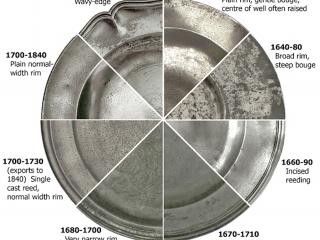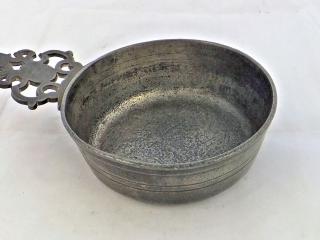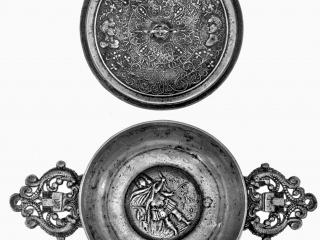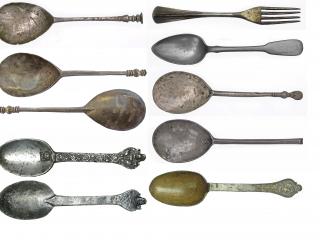Pewter for eating
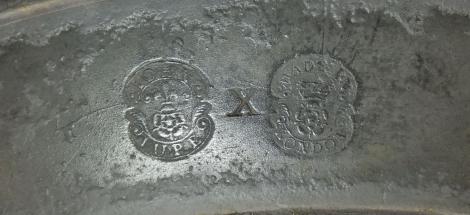
The categories outlined below are those used by the Pewter Society database.
Sadware
Chargers, dishes, plates and saucers were collectively known by pewterers as ‘sadware’.
The boundaries between the four categories were not clearly defined. Indeed, although ‘charger’ is a very old word, pewterers rarely used it, describing all large sadware as ‘dishes’.
Nowadays we tend to say:
- saucer anything under 7″ (17.7 cm) in diameter
- plate 7″ to 11″ (17.7 to 27.8 cm)
- dish 11″ to 18″ (27.9 to 45.6 cm)
- charger anything larger.
In Britain , huge quantities of sadware were made in the period 1650 to 1780 as households right across the social spectrum replaced their wooden trenchers with modern pewter. Sadly only a tiny fraction survives. Styles remained fairly static up to about 1640. New styles then came and went in rapid succession for the next 90 years before once again a stable style emerged which continued until the use of pewter for sadware died out in the 19th century.
The picture shows the most important sadware styles and their main periods of use. Early British sadware is usually characterised by a plain rim, a gently-rounded ‘bouge’ (the bit that joins the rim to the well) and, often, a raised centre to the well. From c1640 there was a vogue for sadware with a steeper bouge and broad rim.
Then from c1660 came a fashion for rims with multiple-reeded edges. Rim widths steadily shrank back to where they had been, though some very narrow rims were produced. Around 1700, the single reeded rim emerged and the plain rim also re-appeared, though without the gentler bouge of the earlier version.
The single reed continued throughout the 18th century on sadware intended for export to America , but for the domestic market it fell out of favour by c1730 and the plain rim then reigned more or less supreme until production of pewter sadware ceased altogether. However, style had one final fling later in the 18th century when there was a fashion for non-circular plates with wavy or polygonal edges amongst the wealthy.
This brief survey covers the main styles of sadware but is not exhaustive. You may come across other types of rim, plates and basins with a deep well, oval plates and dishes, meat dishes and warming plates with a cavity to hold hot water.
If you look on the back of the bouge you will normally see rows of small hammer marks. This hammering was done to strengthen the metal here. If there are no hammer marks, there is a higher probability that the piece is not British or is a 20th century reproduction. Most British sadware is undecorated, but engraved owners’ crests are not uncommon and at the beginning of the 18th century wrigglework decoration had a brief spell of popularity.
Porringers and bowls
Porringers are small bowls with one or two handles which the pewterers called ears*. They were used in England until the mid 18th century, mainly for eating semi-liquid foods like potage or broth but also for other purposes. In America they remained in use until the early 19th century.
They were also widely used in mainland Europe.With their attractive ears, antique English pewter porringers are very decorative, but they are not common and most surviving examples are post-1650. They can be defined by the shapes of their bowls, ears and under-ear brackets, and these features also help with dating.
Most post-1650 English porringers only have a single ear and no lid, but that is not true of Continental examples. Earlier English porringers generally have multi-lobed ears or fleur-de-lys ears.
The Pewter Society has published a detailed and well-illustrated study of post-1650 English porringers based on over 200 examples.
You may come across some specialised porringers:
- Bleeding bowls with graduations inside the bowl
- Commemorative porringers with two ears, a lid and cast decoration on the bowl and lid
- Wine tasters – essentially small, shallow porringers
- Quaiches – the Scottish version of a porringer*
* British silver collectors often wrongly describe all porringers as ‘bleeding bowls’ and use the term ‘porringer’ for a two-handled cup, but that is not what the term meant prior to the 20th century.
Study of post-1650 English porringers
The Pewter Society published a detailed study of post-1650 English porringers in Autumn 2015 and Spring 2016. Part 1 gives some background and covers makers, manufacturers, uses and sizes. Part 2 looks at bowls, brackets, ears and the positioning of makers’ marks, and how these relate to dating and provenance.
The study was accompanied by a spreadsheet of over 200 examples. The spreadsheet is called ‘Table 1’ in the text. A small number of corrections and additions were made to the spreadsheet between the publication of Parts 1 and 2, and again after the publication of Part 2. You may therefore find minor discrepancies between the spreadsheet in its current form and the text of study, but they do not affect the conclusions.
English Porringers post-1650: Part 1
English Porringers post-1650: Part 2
Summary
Bleeding bowls
Bleeding a measured quantity of blood from a patient was supposed to help cure a wide range of ills and remained a common practice until the early 20th century. The blood was caught in a bowl which was often made of pewter. Pewter bleeding bowls look much like ordinary porringers, but they always have straight sides which are graduated internally. The graduations are normally at intervals of 2 fluid ounces (57 millilitres).
Bleeding bowls were still being offered for sale by medical equipment suppliers in 1929, and most surviving pewter examples are 19th or early 20th century, although earlier examples do exist. For more information see pages 12 and 13 of Part 1 of porringer study.
English commemorative porringers
These splendid and decorative porringers all have two ears, a cast medallion in the base of the bowl and a lid or cover with finely-detailed cast decoration. They were made from c1689 into the second quarter of the 18th century. They are rare. Only 25 English examples are known to survive, and that figure includes three bowls without a lid and one lid on a plain bowl.
The majority of bowls depict:
- William & Mary, or
- William III on his own, or
- A figure (probably William III) celebrating the 1697 Treaty of Ryswick
The lids are a little more varied, but just over half depict William & Mary. Many have three knops which allow the lid to be turned over and stood on the table by itself.
Porringers depicting monarchs were not necessarily made during the reign of that monarch, and porringers depicting an event like Ryswick were not necessarily made shortly after that event. From analysis of the makers, we know that some were made as much as 20-30 years later.
A study of these porringers was published in the Journal of the Pewter Society Spring 2013.
Heavily-decorated porringers with lids and two ears are common on the Europe mainland, but we are only aware of one in which the decoration is commemorative rather than simply ornamental.
Spoons and forks
Spoons were made from the necessity of living, and invented earlier than forks. In the 15th Century spoons had various knops, acorns, diamond points or lozenge points, saints, hexangonal knops, lions, seal tops and strawberry tops . These were all easy to produce by casting in a stone or bronze mould.
By the 17th Century simpler styles had evolved. The fancy knops had disappeared and spoons had just a plain slipped top , the end sliced off at an angle. In the 18th Century spoons began to look more like they do today with the ends flattened, a rat's tail on the bowl to strengthen it and a longer shaft. Some of the flattened ends appeared with portraits of the monarch or looked like a dog's nose.
Early forks had only 2 prongs but pewter was too soft to use so early forks were made of latten, a brass alloy, by pewterers. Later the more familiar 3 and 4 prong forks appeared but that was only in the 19th century. To add strength to them steel wires were placed in the middle of the fork and the pewter cast round them.
With the industrial revolution in the middle of the 19th Century mass produced cutlery produced in Sheffield spelt the end of pewter spoons and forks.
Salts
Salt from ancient times was always a very precious commodity ,which is where we get the word salary and below or above the salt. The majority of salts that will be found date from the middle of the 17th century to the 19th century .
The earlier salts will have a shallow bowl for the salt and are normally of a capstan or hexagonal shape. Salts of the 18th century had deeper bowls and became more globular which then developed into a cup salt some from the Georgian period being highly decorated .
Heraldic engraving (pdf format, 102KB)
An Article from a March 1972 Reprint of The Pewter Society Journal by kind permission of Mr John Douglas.
